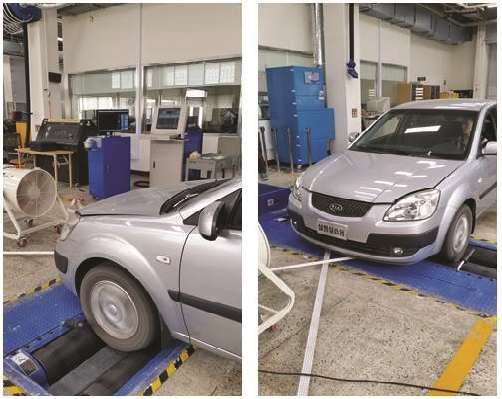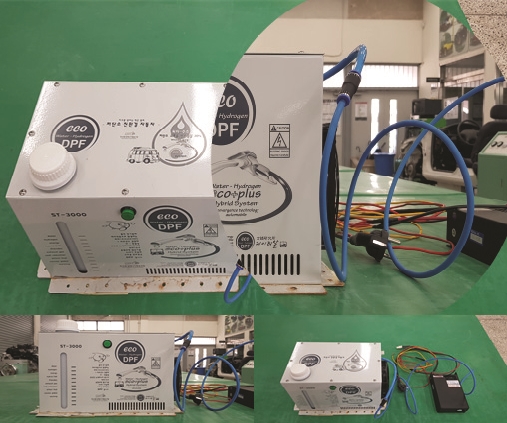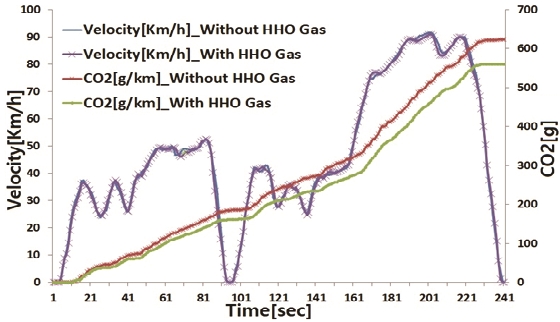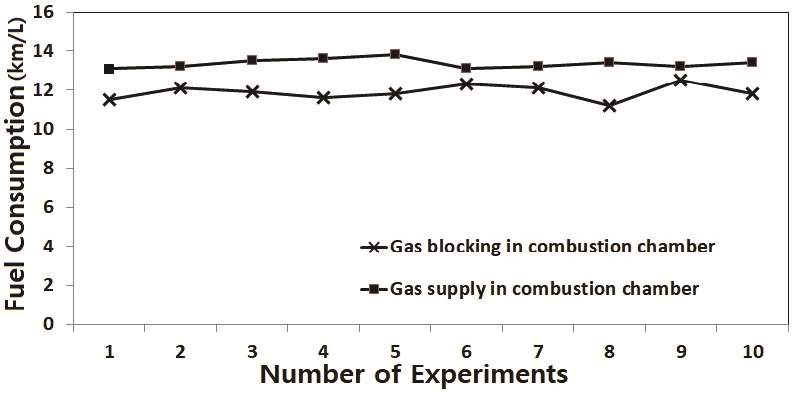
내연기관 흡기다기관 내 연소 촉진제 혼합에 따른 연비 개선 및 유해 배출 가스 감소에 대한 실험적 연구
Copyright Ⓒ 2021 KSAE / 183-07
This is an Open-Access article distributed under the terms of the Creative Commons Attribution Non-Commercial License(http://creativecommons.org/licenses/by-nc/3.0) which permits unrestricted non-commercial use, distribution, and reproduction in any medium provided the original work is properly cited.
Abstract
As a combustion improver, a small amount of Brown gas flowed into the combustion chamber of a gasoline engine. Accordingly, the exhaust gas and fuel efficiency characteristics of the engine were analyzed. Brown gas has different properties from hydrogen. It is a completely non-polluting gas made from the electrolysis of water. It is a mixed gas with a hydrogen to oxygen ratio of 2:1, which is the same as that of water(H2O). Approximately 1,800 L of Brown gas can be obtained through the electrolysis of 1 L of water, and a thermal energy over 2,800 °C can be obtained through combustion. In this study, an experimental device was constructed in order to supply a small amount of Brown gas into the air entering the combustion chamber by connecting a Brown gas generator to the intake manifold of a gasoline engine. The characteristics of the exhaust gas and fuel efficiency according to the addition of Brown gas as a combustion accelerator were analyzed. Under the experimental conditions without changes in the power and torque of the engine, it was confirmed that the cumulative CO, NOx, and CO2 emissions decreased as the driving distance increased. Brown gas as a combustion accelerator induces lean combustion of the engine, from which it is analyzed as the reduction of CO and NOx emissions. The reduction of CO2 emissions is thought to be the result of improved fuel economy.
Keywords:
Brown gas, Intake manifold, Exhaust gases, Fuel efficiency, Combustion chamber, Combustion accelerator키워드:
브라운가스, 흡기다기관, 배기가스, 연비, 연소실, 연소 촉진제1. 서 론
내연기관의 연비특성과 배출가스 조성비 사이에는 많은 인과관계가 있다. 자동차 배기가스 절대량 감소를 위한 방법으로 연비향상을 통해 연소실에 흡입되는 연료의 양을 저감시키는 방법이 효과적이다.1) 이에 따른 방법으로 연소실 내에 연소를 촉진시켜 완전연소에 가깝게 하는 것이 효과적이다. 동일한 목적으로 고연비차량에 대한 연구와 관심이 집중되고 있으며 디젤차량, 하이브리드차량, 전기자동차, 수소연료전지차 등에 대한 연구가 진행되고 있다.2)
본 연구는 내연기관 흡기다기관을 통해 연소실로 유입되는 공기에 연소촉진제로 브라운가스를 소량 혼합하여 연소시켰을 경우에 대하여 연비 특성과 이와 관련된 유해가스 배출량 특성을 분석하였다. 선행연구3)로서 브라운가스를 가솔린기관 혼합가스에 혼합하여 연소실에 유입시켰을 경우 기관 성능과 가솔린 기관의 주요 배기가스 CO, HC, NOx 특성에 대하여 고찰하였다.
브라운 가스는 물을 전기분해하여 얻을 수 있는 완전 무공해 가스로서 수소와 산소의 구성비가 물과 동일한 구성비를 갖는 수소와 산소의 혼합가스로서 자체적으로 산소를 포함하고 있기 때문에 연소특성이 우수하다.4,5) 물 1 L를 전기분해 통해 대략 1,800 L의 브라운가스를 얻을 수 있으며 연소를 통해 2,800 °C 이상의 고온의 열에너지를 얻을 수 있다.
본 연구에서는 가솔린 기관 흡기다기관에 브라운가스 발생장치를 연결하여 연소실로 들어가는 공기 속에 브라운가스가 유입되도록 실험장치를 구성하였다. 소량의 브라운가스가 연소실로 혼입되어 연소 시 산화를 촉진함으로써 폭발력 증대에 다른 연비특성과 배출되는 유해가스 배출 특성을 고찰하였다. 브라운가스 생성을 위한 에너지 소모의 최소화와 빠른 연소 특성에 따른 역화 방지를 위해 소량의 브라운가스를 연소실에 유입도록 실험장비를 구성하였다.
2. 실험장치 및 방법
실험 엔진 흡기다기관 입구에 브라운가스 발생장치를 연결하였고, 브라운가스 유⋅무에 따른 배기가스와 연비 특성을 분석하기 위하여 배기가스 분석 장치를 연결하였다. 연비는 차대동력계를 통해 측정하였다. 실험 개략도를 Fig. 1에 나타내었다.
실험은 J사의 5.5 톤 차대 동력계를 사용하여 실험하였으며 엔진과 차대동력계 사양은 Tables 1, 2와 같다. Photo. 1은 실험차량의 차대동력계상에 정렬 및 장비구성을 나타내고 있으며, Photo. 2는 실험에 사용된 브라운가스 발생장치 사진이다.
흡기다기관 입구에 흡입되는 공기에 브라운가스가 유입되도록 설치하여 가스가 공급될 경우와 공급되지 않을 경우에 대하여 각각 10회의 실험을 진행하여 CO2 배출량과 연비를 측정하여 비교 분석하였다.
실험 차량 운전조건은 차대동력계에서 실시되는 IM240 운전모드로 실험하였다. IM240 운전모드는 운행차 배출가스 시험방법으로 유럽에서 배출가스 측정에 사용되고 있다. 차량을 차대동력계에 정렬시킨 후 배기가스 분석기를 연결하여 차대동력계에서 지시하는 운전 조건을 따라가며 240초 동안 1회씩 각각 10회의 실험을 진행하였다. 엔진 출력의 동일한 조건을 유지하기 위하여 차량 앞에는 송풍기를 설치하여 엔진 냉각을 위한 냉각팬 작동이 되지 않도록 하였다.
3. 실험 결과
브라운가스 첨가에 따른 배출가스와 연비 변화 특성을 분석하고자 하였다. 브라운가스 첨가 유무에 따른 결과의 비교⋅분석을 위해, 실험 중 출력과 토크의 변화가 없게 두 운전조건이 일치되도록 실험하였다. 또한 과도한 브라운가스로 인한 역화 및 배터리 소모 방지를 위해 실험엔진 2,000 rpm(체적효율 0.9)에서 흡기 체적유량(0.0239 m3/sec)의 약 0.3 %의 브라운가스(0.7×10-4 m3/sec)를 흡입되는 공기에 첨가되도록 브라운가스 발생장치를 설정하였다.
Fig. 2는 브라운가스 첨가 유⋅무에 따른 CO, HC, NOx 배출특성으로 각각 10회씩 이루어진 실험 결과를 나타내었다. HC는 실험조건에 큰 변화 없는 배출특성을 나타냈으며, CO, NOx의 경우 각각 평균 59 %, 94 %의 저감 특성을 보였다.
Fig. 3에는 브라운가스 첨가 유⋅무에 따른 CO2 배출 특성을 나타내고 있다. 그래프에 표시되는 CO2 배출량은 운행시간에 따른 누적 배출량을 표시한다. 동일한 IM240 운전모드로 동력계에서 지시하는 조건을 따라 운전되었으며 Fig. 3 운전조건의 그래프를 볼 때 출력과 토크의 변화가 없이 진행되었음을 알 수 있다. 즉, 엔진 성능의 변화 없는 조건에서 차량운행시간이 증가할수록 브라운가스가 첨가되었을 경우 첨가하지 않은 상태보다 누적 CO2 배출량이 감소하는 것을 확인할 수 있다. CO2 배출량은 연비와 밀접한 관계를 갖고 있다. 탄화-수소계 연료와 산소가 연소 반응하여 만들어지는 부산물은 CO2, H2O, CO, HC, 질소산화물 등으로 변환되어 배출된다. 형태는 바뀌지만 연소 전후의 전체질량 합은 보존되어야 한다. 연료의 연소가 희박연소로 이동할수록 CO, HC, 질소산화물 등 직접적 인체 유해 배기가스의 양은 줄어드나 CO2의 양은 늘어나게 된다. 따라서 연소 후 발생하는 CO2의 양을 줄이기 위해서는 앞서 반응하는 탄화-수소계 연료의 양을 줄이는 방법이 효과적이다. 이 조건을 충족하기 위해서는 연비향상이 절대적이다. Fig. 3에 나타난 결과는 연소실에 유입되는 혼합기에 HHO 가스를 혼합함으로써 운행시간 증가에 따른 연비 성능 향상 결과로 분석된다.
실험의 차대 동력계로부터 운행시간 평균연비를 얻을 수 있다. 각각 10회의 실험 결과를 Fig. 4에 나타내었다. 평균 연비 결과가 브라운가스 미첨가 시 11.88 ㎞/L, 브라운가스를 첨가했을 경우 연비가 13.33 ㎞/L 실험 결과로 대략 12.2 %의 연비가 향상된 결과를 나타내었다.
4. 결 론
물 분해를 통한 브라운가스 발생장치를 차량 흡기 다기관 입구에 설치하여 연소실로 연소촉진제로서 브라운가스가 첨가될 수 있도록 실험 장치를 구성하였다. 연소실로의 브라운가스 유입 유⋅무에 따른 배출가스특성과 연비 특성을 비교 분석한 결과는 다음과 같다.
- 1) 출력과 토크의 변화가 없는 실험 조건에서, 운행거리 증가에 따른 누적 CO, NOx, CO2의 배출량이 감소함을 확인하였다. 연소촉진제로서 브라운가스 첨가가 엔진의 희박연소를 유도하였고, 이로부터 CO, NOx의 배출량 감소로 이어진 것으로 분석된다. CO2 배출량 감소는 연비 향상의 결과로 사료된다. 브라운가스 연소 특성으로부터 엔진 연소효율 향상이 연비의 향상으로 이어졌고, 연비 향상에 따른 CO2 배출량 감소로 나타난 것으로 분석된다.
- 2) 브라운가스 생성을 위한 가스 발생장치의 에너지 소모율과 브라운가스의 연소실 공급에 따른 연비 향상 효과에 대한 경제적 측면에서의 분석이 후속 연구로 진행 계획이며, 240초의 제한적인 실험조건보다 장기 운전조건에서 실험 진행이 필요할 것으로 사료된다. 장기 운전조건 실험을 통해 짧은 실험조건에서 발생 할 수 있는 오류를 최소화할 것으로 예측된다.
Acknowledgments
본 논문은 2021년도 서일대학교 학술연구비에 의해 연구되었음.
References
- J. H. Yoo, D. W. Kim, Y. S. Yoo, M. D. Eum, J. C. Kim, S. W. Lee and D. S. Baik, “Study on the Characteristics of Carbon Dioxide Emissions Factors from Passenger Cars,” Transactions of KSAE, Vol. 17, No.4, pp.10-15, 2009.
- B. S. Kil, C. P. Cho, Y. D. Pyo and G. C. Kim, “Optimized Strategy of Neighborhood Electric Vehicle with Driving Schedules,” Transactions of KSAE, Vol.18, No.3, pp.53-59, 2010.
-
G. S. Kim, S. C. Park and J. H. Cho, “A Study on the Characteristics of Exhaust Gas in Gasoline Engine by HHO Gas,” Journal of the Korean Society of Mechanical Technology, Vol.19, No.4, pp.507-512, 2017.
[https://doi.org/10.17958/ksmt.19.4.201708.507]

-
H. Jung, J. Y. Jo and C. H. Lee, “Validity Investigation on Hydrogen Dual Fuel of Diesel Internal Combustion Engine Using Brown Gas,” Journal of the Korean Society of Mechanical Technology, Vol.15, No.5, pp.779-784, 2013.
[https://doi.org/10.17958/ksmt.15.5.201310.779]

-
K. H. Park, J. Y. Kim, C. J. Kim, E. J. Lee, K. Son and S. H. Park, “The Effect of HHO Gas on the Performance of Industrial Diesel Engine Using Biodiesel Blended Fuel,” Journal of Advanced Marine Engineering and Technology, Vol.35, No.8, pp.1022-1027, 2011.
[https://doi.org/10.5916/jkosme.2011.35.8.1022]








